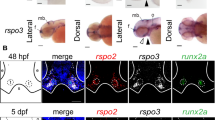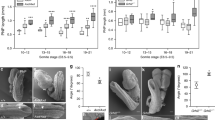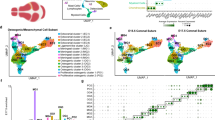Abstract
During skull development, the cranial connective tissue framework undergoes intramembranous ossification to form skull bones (calvaria). As the calvarial bones advance to envelop the brain, fibrous sutures form between the calvarial plates1. Expansion of the brain is coupled with calvarial growth through a series of tissue interactions within the cranial suture complex2. Craniosynostosis, or premature cranial suture fusion, results in an abnormal skull shape, blindness and mental retardation3. Recent studies have demonstrated that gain-of-function mutations in fibroblast growth factor receptors (fgfr) are associated with syndromic forms of craniosynostosis4,5. Noggin, an antagonist of bone morphogenetic proteins (BMPs), is required for embryonic neural tube, somites and skeleton patterning6,7,8. Here we show that noggin is expressed postnatally in the suture mesenchyme of patent, but not fusing, cranial sutures, and that noggin expression is suppressed by FGF2 and syndromic fgfr signalling. Since noggin misexpression prevents cranial suture fusion in vitro and in vivo, we suggest that syndromic fgfr-mediated craniosynostoses may be the result of inappropriate downregulation of noggin expression.
This is a preview of subscription content, access via your institution
Access options
Subscribe to this journal
Receive 51 print issues and online access
$199.00 per year
only $3.90 per issue
Buy this article
- Purchase on Springer Link
- Instant access to full article PDF
Prices may be subject to local taxes which are calculated during checkout




Similar content being viewed by others
References
Slavkin, H. C. Developmental Craniofacial Biology (Lea & Febiger, Philadelphia, 1979)
Thilander, B. Basic mechanisms in craniofacial growth. Acta Odontol. Scand. 53, 144–151 (1995)
McCarthy, J. G., Epstein, F. J. & Wood-Smith, D. in Plastic Surgery (ed. McCarthy, J. G.) 3013–3053 (W.B. Saunders Co., Philadelphia, 1990)
Cohen, M. M. Jr Craniosynostoses: phenotypic/molecular correlations. Am. J. Med. Genet. 56, 334–339 (1995)
Wilkie, A. O. M. Craniosynostosis: genes and mechanisms. Hum. Mol. Genet. 6, 1647–1656 (1997)
Brunet, L. J., McMahon, J. A., McMahon, A. P. & Harland, R. M. Noggin, cartilage morphogenesis, and joint formation in the mammalian skeleton. Science 280, 1455–1457 (1998)
McMahon, J. A. et al. Noggin-mediated antagonism of BMP signaling is required for growth and patterning of the neural tube and somite. Genes Dev. 12, 1438–1452 (1998)
Capdevila, J. & Johnson, R. L. Endogenous and ectopic expression of noggin suggests a conserved mechanism for regulation of BMP function during limb and somite patterning. Dev. Biol. 197, 205–217 (1998)
Warren, S. M. et al. New developments in cranial suture research. Plast. Reconstr. Surg. 107, 523–540 (2001)
Opperman, L. A., Nolen, A. A. & Ogle, R. C. TGF-beta 1, TGF-beta 2, and TGF-beta 3 exhibit distinct patterns of expression during cranial suture formation and obliteration in vivo and in vitro. J. Bone Miner. Res. 12, 301–310 (1997)
Greenwald, J. A. et al. Regional differentiation of cranial suture-associated dura mater in vivo and in vitro: implications for suture fusion and patency. J. Bone Miner. Res. 15, 2413–2430 (2000)
Wozney, J. M. et al. Novel regulators of bone formation: Molecular clones and activities. Science 242, 1528–1534 (1988)
Wang, E. A. et al. Recombinant human bone morphogenetic protein induces bone formation. Proc. Natl Acad. Sci. USA 87, 2220–2224 (1990)
Zimmerman, L. B., De Jesus-Escobar, J. M. & Harland, R. M. The Spemann organizer signal noggin binds and inactivates bone morphogenetic protein 4. Cell 86, 599–606 (1996)
Hsu, D. R., Economides, A. N., Wang, X., Eimon, P. M. & Harland, R. M. The Xenopus dorsalizing factor gremlin identifies a novel family of secreted proteins that antagonize BMP activities. Mol. Cell 1, 673–683 (1998)
Capdevila, J., Tsukui, T., Rodriquez Esteban, C., Zappavigna, V. & Izpisua Belmonte, J. C. Control of vertebrate limb outgrowth by the proximal factor Meis2 and distal antagonism of BMPs by gremlin. Mol. Cell 4, 839–849 (1999)
Minabe-Saegusa, C., Saegusa, H., Tsukahara, M. & Noguchi, S. Sequence and expression of a novel mouse gene PRDC (protein related to DAN and cerberus) identified by a gene trap approach. Dev. Growth Differ. 40, 343–353 (1998)
Brunkow, M. E. et al. Bone dysplasia sclerosteosis results from loss of the SOST gene product, a novel cystine knot-containing protein. Am. J. Hum. Genet. 68, 577–589 (2001)
Gazzerro, E., Gangji, V. & Canalis, E. Bone morphogenetic proteins induce the expression of noggin, which limits their activity in cultured rat osteoblasts. J. Clin. Invest. 102, 2106–2114 (1998)
Greenwald, J. A. et al. In vivo modulation of FGF biological activity alters cranial suture fate. Am. J. Pathol. 158, 441–452 (2001)
Moore, R., Ferretti, P., Copp, A. & Thorogood, P. Blocking endogenous FGF-2 activity prevents cranial osteogenesis. Dev. Biol. 243, 99–114 (2002)
Mansukhani, A., Bellosta, P., Sahni, M. & Basilico, C. Signaling by fibroblast growth factors (FGF) and fibroblast growth factor receptor 2 (FGFR2)-activating mutations blocks mineralization and induces apoptosis in osteoblasts. J. Cell Biol. 149, 1297–1308 (2000)
Bradley, J. P. et al. Studies in cranial suture biology: in vitro cranial suture fusion. Cleft Palate–Craniofac. J. 33, 150–156 (1996)
Dixon, M. E., Armstrong, P., Stevens, D. B. & Bamshad, M. Identical mutations in NOG can cause either tarsal/carpal coalition syndrome or proximal symphalagism. Gen. Med. 3, 349–353 (2001)
Roth, D. A. et al. Studies in cranial suture biology. I. Increased immunoreactivity for transforming growth factor-beta (β1, β2, β3) during rat cranial suture fusion. J. Bone Miner. Res. 12, 311–321 (1997)
Bradley, J. P., Levine, J. P., Roth, D. A., McCarthy, J. G. & Longaker, M. T. Studies in cranial suture biology. IV. Temporal sequence of posterior frontal cranial suture fusion in the mouse. Plast. Reconstr. Surg. 98, 1039–1045 (1996)
Albrecht, U., Helms, J. A. & Lin, H. in Molecular and Cellular Methods in Developmental Toxicology (ed. Daston, G. P.) 23–48 (CRC Press, Boca Raton, 1997)
Paine-Saunders, S., Viviano, B. L., Economides, A. N. & Saunders, S. Heparan sulfate proteoglycans retain noggin at the cell surface: A potential mechanism for shaping bone morphogenetic protein gradients. J. Biol. Chem. 277, 2089–2096 (2002)
Acknowledgements
We thank C. J. Tabin, I. Thesleff, D. M. Kingsley and N. Quarto for comments and suggestions on this manuscript, and K. D. Fong, J. A. Mathy and R. P. Nacamuli for their technical assistance. The human fgfr2, fgfr2/S252W (Apert) and fgfr2/C342Y (Crouzon) retroviral constructs were provided by A. Mansukhami and C. Basilico (New York University). This work was supported by NIH grants (R.M.H. and M.T.L.) and a Lyndon Peer/PSEF Fellowship (S.M.W.).
Author information
Authors and Affiliations
Corresponding author
Ethics declarations
Competing interests
The authors declare that they have no competing financial interests.
Supplementary information
Rights and permissions
About this article
Cite this article
Warren, S., Brunet, L., Harland, R. et al. The BMP antagonist noggin regulates cranial suture fusion. Nature 422, 625–629 (2003). https://doi.org/10.1038/nature01545
Received:
Accepted:
Issue Date:
DOI: https://doi.org/10.1038/nature01545
This article is cited by
-
The roles and regulatory mechanisms of TGF-β and BMP signaling in bone and cartilage development, homeostasis and disease
Cell Research (2024)
-
Middle meningeal artery embolization and pediatric chronic subdural hematoma: a systematic review of the literature
Neurosurgical Review (2023)
-
Stage-specific requirement for METTL3-dependent m6A modification during dental pulp stem cell differentiation
Journal of Translational Medicine (2022)
-
Signaling network regulating osteogenesis in mesenchymal stem cells
Journal of Cell Communication and Signaling (2022)
-
Insights and future directions of potential genetic therapy for Apert syndrome: A systematic review
Gene Therapy (2021)
Comments
By submitting a comment you agree to abide by our Terms and Community Guidelines. If you find something abusive or that does not comply with our terms or guidelines please flag it as inappropriate.



